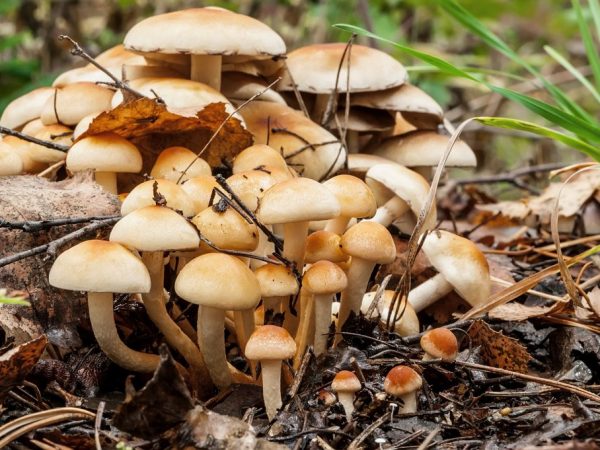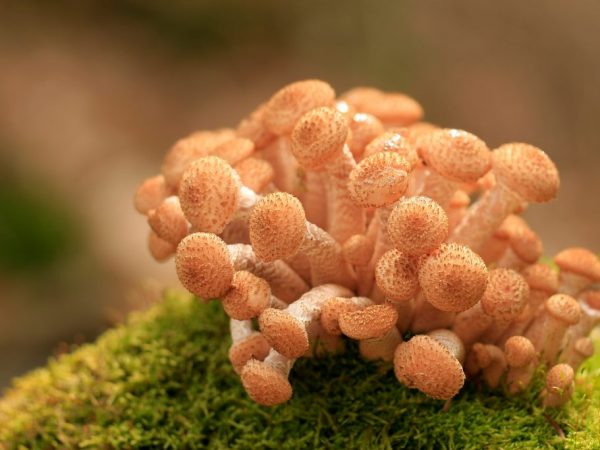Characteristics of the autumn mushroom
Autumn honey agaric is a species that is often found in the forests of almost most climatic zones of the Northern Hemisphere (starting with the subtropics), except for areas with permafrost. It grows in large clusters on stumps, near old trees, and sometimes next to shrubs.

Characteristics of the autumn mushroom
The appearance of the mushroom
After the summer heat, late mushrooms appear at the foot of the trees. They reach large sizes in 6-8 days. Autumn honeydew is characterized by a large cap of about 3-15 cm in diameter, which is flattened in the center. It is brownish-yellow in color, spherical in shape, with brown scales, the edge of the cap looks inward. The difference from the representatives of the summer mushroom species is in the darker color of the cap. In young mushrooms that are developing, the film connecting the stem to the cap breaks and then hangs in a white ring under the cap. It is this ring that mushroom pickers call "skirt".
The leg is dense, reaching 18 cm in height, and up to 2.5 cm in diameter. The shape is cylindrical, the base is slightly widened. Attention! We are not talking about bloating. The structure is fibrous, the surface is flaky-scaly.
The pulp is white, does not change color at the break, has a good smell and taste, dense, thin-fleshy in the cap.
The plates of autumn honeydew are whitish, often covered with small specks that look like rust. Spores are in the form of a white powder, their size is 6-8 microns.
Irina Selyutina (Biologist):
Beginning mushroom pickers often, due to their carelessness, confuse autumn honey fungus with an inedible gray-yellow false foam and an edible twin - a brick-red false foam. Also, very often, autumn honey fungus is collected together with scaly flakes (which are very similar to it). But this, as the Russian mycologist M. Vishnevsky points out, is not scary, because this type of flake, despite the slight bitterness, is also tasty and has healing properties.
Sometimes the honey fungus is separately isolated, which bears fruit from August to October, as a result of which it is called autumn. It differs from the usual autumn with a swollen leg, a cobweb private veil and the fact that it chooses forest litter and sometimes dead trees for growth sites. These are closely related species, and the differences between the thick-legged and the autumn forest are not as significant as between the last and the summer forest.
Poisonous twin
Also, the autumn mushroom has a dangerous poisonous twin that looks almost like a real one and grows in the same places: at the foot of the trees. Doubles have a well-defined name - false mushrooms.
When picking mushrooms, it is important to know how to distinguish real mushrooms from false ones. The following features can help you with this:
- Hat color: in poisonous mushrooms, it is more brightly colored and comes in rusty brown, brick or orange colors.
- Head surface: the false mushroom has a smooth cap, while in the edible it is covered with scales that differ in color from the cap itself. The late dark, slightly gray fungus also loses these scales over time.
- Hymenophore plate color: an inedible mushroom has green, yellow or black plates. In ordinary honey agarics, they are cream or white.
- Smell: a poisonous mushroom smells like mold or earth and has a bitter taste, while the real one has a distinct mushroom aroma.
- "Skirt" on the leg: it is characteristic only for real autumn mushrooms, and for false ones it is absent.
Beneficial features

Honey mushrooms are useful for anemia
The benefits of eating this type of mushroom are great. They contain many useful substances, such as:
- vitamins of group B (most of all B1 and B2), also C, PP and E;
- phosphorus, iron, zinc, calcium and other trace elements;
- sufficient amino acid content;
- cellulose;
- proteins.
Nutritional value (BJU) of 100 g of mushrooms looks like this:
- 2.2 g of proteins;
- 1.2 g fat;
- 0.5 g of carbohydrates.
According to the description, the amount of trace elements in the mushroom is close to that in the composition of river fish, so mushrooms will be an excellent alternative to seafood, and will also help diversify the daily diet. The calorie content of autumn honey agaric per 100 g of the product is 17 kcal, which makes them practically indispensable for those who "sit" on diets. Autumn mushroom will be an excellent choice for vegetarians who refuse to eat fish and meat. Its use will serve as the prevention of disorders associated with bone tissue.
Mushrooms have antimicrobial properties and are considered a natural antiseptic, and they also have anti-cancer properties. It is useful to take them for problems with the gastrointestinal tract: they fight bacteria as well as antibiotics or garlic. Eating these mushrooms regularly can help prevent heart disease.
They have found their application in medicine in the treatment and prevention of the following diseases:
- fibroma;
- myoma;
- adenoma;
- mastopathy;
- thrombophlebitis;
- increased blood clotting, etc.
Honey mushrooms are also useful for anemia, because the high content of magnesium, copper and other trace elements helps to improve hematopoiesis. For this, only 100 g of these mushrooms per day is enough. In addition, they will be useful for those who suffer from Escherichia coli or Staphylococcus aureus.
Contraindications
With all the advantages of honey agarics, they also have a number of contraindications, in the presence of which their use should be either limited or completely stopped. They are contraindicated:
- women during pregnancy and lactation;
- people with heart pathologies;
- those who have digestive problems;
- people with kidney failure.
The mushroom should also not be given to children under the age of 12, which is associated with the immaturity of the digestive system and its inability to absorb some of the constituents of the mushroom pulp, which can lead to intoxication of the body and health problems.
Excessive consumption of honey agaric in food leads to pancreatitis, inflammation of the pancreas, problems with the gastrointestinal tract. Before use, it is necessary to carry out mandatory heat treatment of mushrooms.
Application
Honey honey is used in folk medicine as a natural antibiotic; alcoholic tinctures are made on its basis. These mushrooms are used as a natural laxative. In households, they are often added to food, used for preservation, pickling, etc.
Irina Selyutina (Biologist):
Due to their rigidity, it is better not to collect the legs of autumn honey agaric - you are unlikely to use them. When preparing for future use, it is worth remembering that raw honey mushrooms can be very slightly poisonous, therefore, dry and cold salting is not suitable for them, you can only use hot and then only after preliminary boiling. It is also known that a slight toxicity in honey agaric may appear after the first frost begins.
By the way. To prepare hot dishes, honey mushrooms are pre-boiled for 30 minutes.
An excellent option for preserving honey agarics in the winter is freezing. This way they retain their entire rich biochemical composition.The main thing is that the freezing is fast (its second name is shock).
Honey mushrooms are a great option for adding them to the diet of various diets. They contain chitin, a substance that helps to bind fat molecules and remove them from the body.
Conclusion
Autumn honey fungus is an edible mushroom that has many beneficial properties. It is easy to find in the forest and always paired up with others, allowing you to quickly fill your basket. The main thing is to remember the differences between false mushrooms and real ones and perform mandatory heat treatment before eating them.



